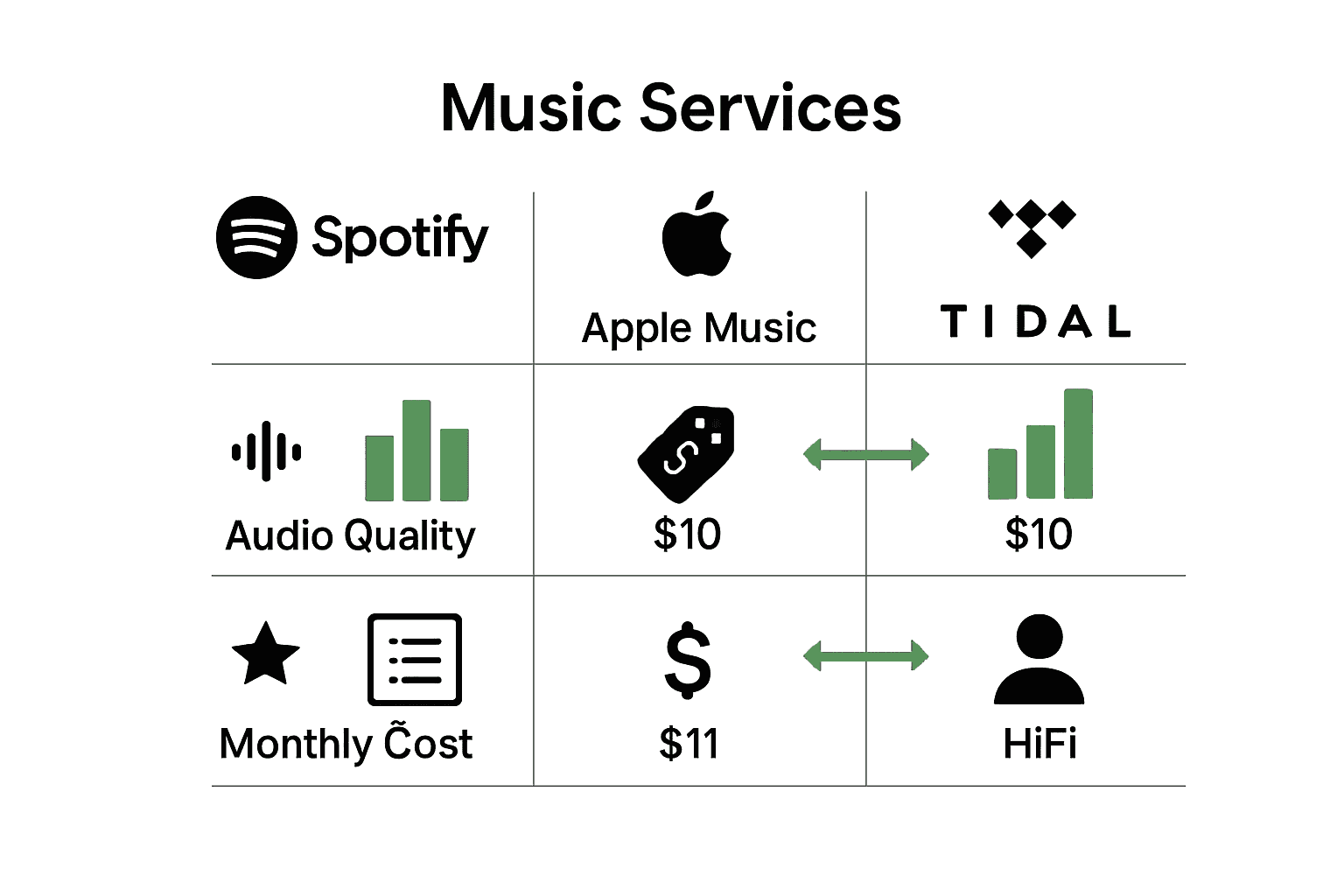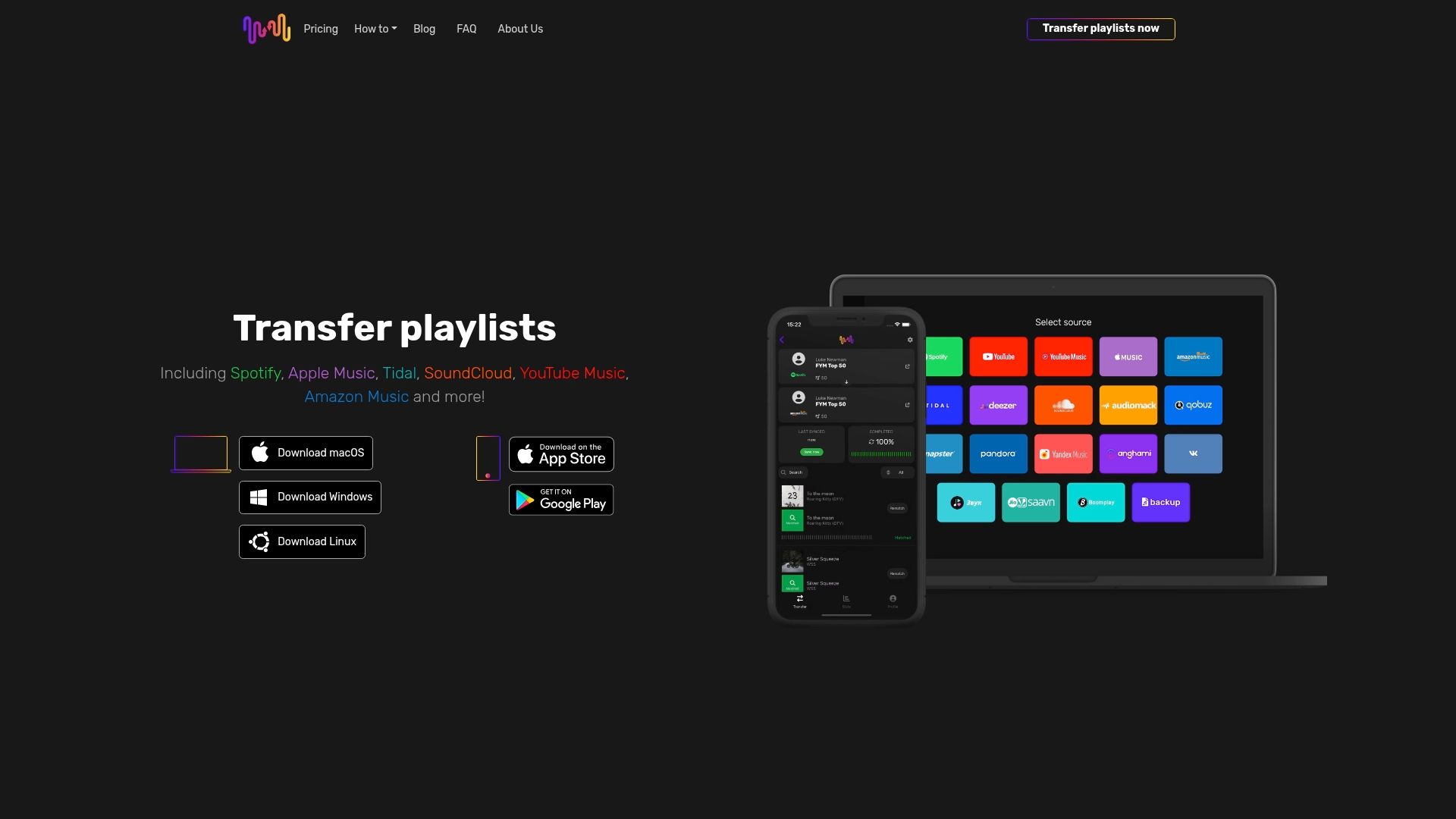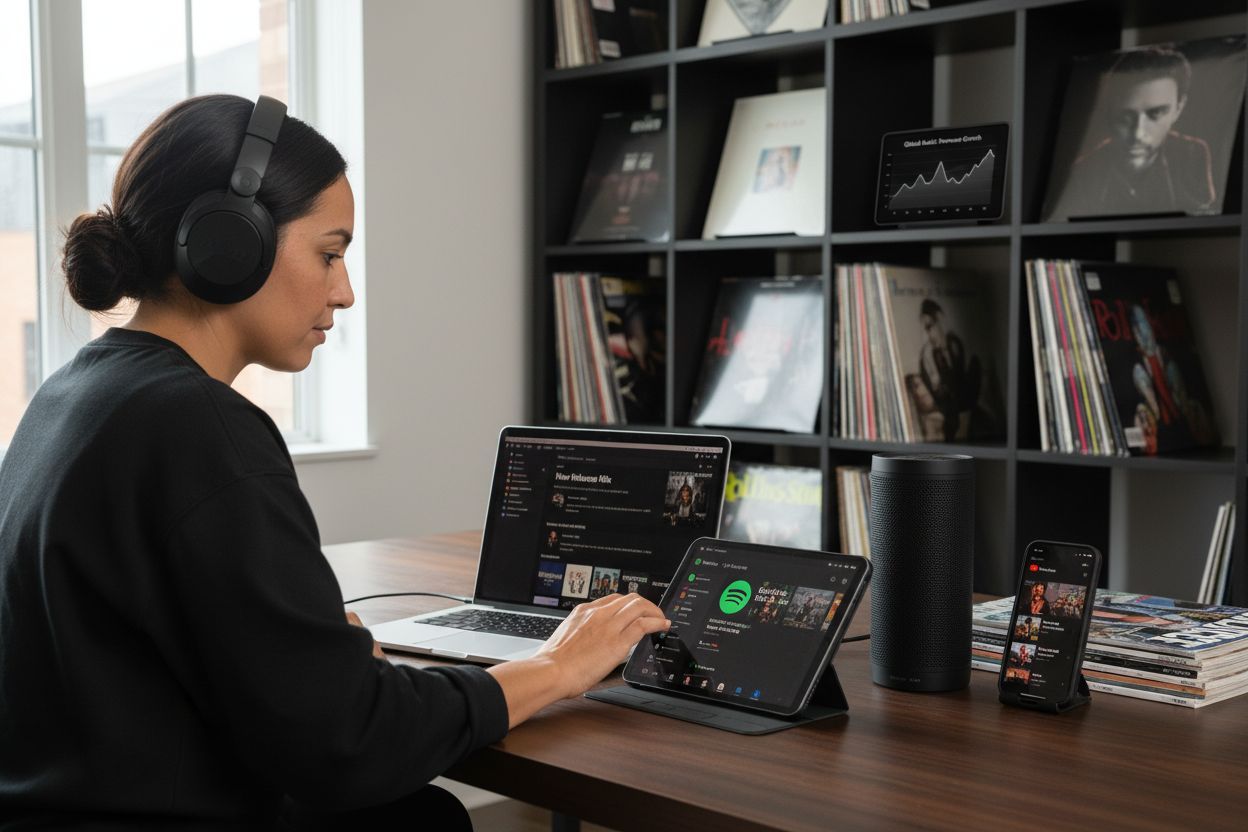Did you know that over 84 percent of global music revenue now comes from streaming platforms? This shift has changed not only how we listen to music but also how artists earn a living and how fans discover new sounds. Picking the right streaming service affects the music you hear, the audio quality you enjoy, and even what you pay each month. Understanding these choices can help you get more out of every listening session.
Key Takeaways
| Point | Details |
|---|---|
| Music Streaming Transformation | Music streaming platforms provide instant access to extensive music libraries, altering music consumption patterns and revenue models for artists. |
| Platform Variations | Different music streaming services cater to diverse listener preferences, offering features like audio quality, ecosystem integration, and unique content. |
| Personalization and Discovery | Advanced algorithms enhance user experiences by delivering personalized music recommendations and dynamic playlist updates based on individual preferences. |
| Financial and Technical Considerations | Users must navigate complex financial realities of artist royalties and various technical limitations that may affect their music streaming experience. |
Table of Contents
- Defining Music Streaming Platforms Clearly
- Major Types of Music Streaming Services
- Core Features and How Users Benefit
- How Playlist Migration Works Across Platforms
- Comparing Leading Music Streaming Services
- Risks, Costs, and Limitations to Consider
Defining Music Streaming Platforms Clearly
A music streaming platform is an online digital service that allows users to listen to vast libraries of audio content remotely through internet-connected devices. These platforms fundamentally transform how we consume music by providing instant access to millions of songs without downloading individual tracks.
The core mechanics of streaming platforms revolve around several key features:
- Unlimited music library access
- Personalized playlist creation
- Algorithm-driven music recommendations
- Offline listening capabilities
- Cross-device synchronization
According to a comprehensive academic study, streaming platforms represent more than just entertainment technology - they're complex economic ecosystems. The research introduces innovative approaches to understanding revenue distribution, highlighting how these platforms aren't just about music consumption but also about creating intricate cooperative economic models.
Unlike traditional music purchasing methods, streaming platforms operate on subscription or ad-supported models. Users can explore vast musical landscapes without purchasing individual albums, paying instead for continuous access. This model has dramatically reshaped how artists earn revenue and how listeners discover new music, making musical exploration more accessible than ever before. Learn more about transferring your music between platforms to maximize your listening experience.
Major Types of Music Streaming Services
Music streaming services have evolved into diverse platforms catering to different listener preferences and needs. Understanding these variations helps users select the most suitable service for their musical journey.
Mainstream Platforms
These popular services offer comprehensive music libraries and user-friendly interfaces:
- Spotify: Known for extensive playlist curation and social sharing
- Apple Music: Seamlessly integrated with Apple ecosystem
- Amazon Music: Bundled with Prime membership
- Tidal: Emphasizes high-fidelity audio quality
Video-Audio Hybrid Services
YouTube Music represents a unique category, combining audio and video streaming experiences. According to Wikipedia, this platform is available globally in over 119 countries, offering:
- Ad-supported free tier
- Premium subscription with background play
- Downloadable tracks for offline listening
- Extensive music video integration
Audiophile-Focused Platforms
Specialized streaming services target discerning listeners seeking superior audio quality. Qobuz, for instance, caters to audiophiles by providing:
- Digital download options
- High-resolution lossless audio (up to 24-bit/192 kHz)
- Targeted content for music enthusiasts
Each streaming platform offers distinct features, allowing music lovers to choose based on their specific preferences and listening habits. Learn more about seamlessly transferring your playlists across different streaming services to maximize your musical experience.
Here's a comparison of leading music streaming platforms and their distinctive features:
| Platform | Audio Quality | Key Strengths | Special Features |
|---|---|---|---|
| Spotify | Standard Upcoming HiFi |
Music discovery Social sharing |
Collaborative playlists AI curation |
| Apple Music | Lossless Spatial Audio |
Ecosystem integration | Siri voice control Live radio |
| Tidal | HiFi Master quality audio |
Audiophile-grade sound | Artist royalties Exclusive content |
| YouTube Music | Standard | Video-audio hybrid | Music videos Global reach |
| Amazon Music | Standard HD options |
Prime bundle value | Alexa integration Podcasts |
| Qobuz | High-resolution Lossless |
Audiophile content Editorial |
Digital downloads Hi-res catalog |
Core Features and How Users Benefit
Music streaming platforms today offer far more than simple audio playback.
 Modern services have transformed into comprehensive entertainment ecosystems designed to enhance user experience through innovative features and personalized interactions.
Modern services have transformed into comprehensive entertainment ecosystems designed to enhance user experience through innovative features and personalized interactions.
Personalization and Discovery
Streamers prioritize creating intelligent, adaptive experiences:
- AI-powered playlist generation
- Mood and activity-based music recommendations
- Weekly curated playlist updates
- Machine learning algorithm tracking listener preferences
According to research from analytics experts, platforms like Spotify and Apple Music excel at delivering hyper-personalized musical journeys. Each service uses sophisticated algorithms to understand individual taste, continuously refining recommendations based on listening history.
Audio Quality and Content Diversity
Comprehensive streaming service analysis reveals significant variations in platform offerings:
- Tidal: High-fidelity FLAC audio for audiophiles
- Apple Music: Lossless audio and immersive Spatial Audio
- Spotify: Massive library with upcoming hi-fi tier
- YouTube Music: Unique video content integration
Beyond music, modern platforms have expanded into multimedia experiences. Podcasts, audiobooks, exclusive artist content, and social sharing features transform streaming from a passive listening activity into an interactive entertainment platform. Learn more about transferring your musical collections seamlessly across different services to unlock maximum musical potential.
How Playlist Migration Works Across Platforms
Playlist migration represents a complex technical process involving the transfer of musical collections between different streaming services. While seemingly straightforward, this process involves intricate technological and licensing challenges that can significantly impact user experience.
Technical Challenges in Migration
Playlist transfers encounter multiple potential obstacles:
- Metadata inconsistencies between platforms
- Licensing restrictions on specific tracks
- Regional music availability differences
- Variations in audio file formats and quality
According to The Verge's investigation, even built-in transfer tools like Apple Music's have significant limitations. For instance, the platform excludes platform-generated playlists and requires users to resolve unmatched tracks within 30 days of transfer.
Migration Strategies
Research on playlist migration best practices highlights critical considerations for successful transfers. Users must be prepared to:
- Manually verify track matching
- Check regional content availability
- Potentially recreate certain playlists
- Understand potential metadata translation issues
The complexity of playlist migration underscores the importance of using specialized transfer tools that can navigate these technological hurdles.
 Learn more about seamless playlist transfers to ensure your music collection remains intact across different streaming platforms.
Learn more about seamless playlist transfers to ensure your music collection remains intact across different streaming platforms.
Comparing Leading Music Streaming Services
Music streaming services have distinct characteristics that cater to different listener preferences, making the selection process more nuanced than simply choosing a platform with the largest music library.
Platform Specialization
Each leading service offers unique advantages:
- Spotify: Masters of music discovery and social sharing
- Apple Music: Seamless ecosystem integration
- Tidal: Audiophile-grade sound quality
- YouTube Music: Innovative video-audio hybrid
- Amazon Music: Prime member value proposition
- Qobuz: High-resolution audio with editorial content
According to Sound Guys' comprehensive analysis, these platforms aren't just music repositories but sophisticated entertainment ecosystems designed to match specific user needs.
Audio Quality and Content Strategy
TechRadar's research positions Tidal as particularly compelling for audiophiles, highlighting its:
- High-resolution audio capabilities
- Extensive track library
- Competitive pricing with Apple Music
- Superior audio interface design
The modern streaming landscape is less about who has the most songs and more about providing tailored, high-quality listening experiences.
Explore how to transfer your playlists between these platforms and maximize your musical journey.
Risks, Costs, and Limitations to Consider
Music streaming platforms offer incredible convenience, but users must understand the complex financial and technological landscape underlying these services. Not all that glitters is musical gold.
Financial Implications
Research from Investopedia reveals striking economic realities in music streaming:
- Streaming dominates music revenue (84%)
- Artist payouts remain extremely low
- Pandora pays ~$0.0013 per play
- Spotify pays ~$0.003–$0.005 per stream
Consumer Cost Perspectives
According to a comprehensive consumer survey, users demonstrate nuanced attitudes toward streaming costs:
- Average annual streaming expenditure: $75
- Desired monthly price: Under $10
- Perception: Convenient but potentially overpriced
Hidden Technical Limitations
Streaming platforms impose several critical constraints:
- Limited offline listening windows
- Geographic content restrictions
- Variable audio quality
- Potential digital rights management complications
Understanding these challenges helps consumers make informed decisions. Learn strategies for maximizing your music streaming experience while minimizing potential drawbacks.
Effortless Playlist Migration for Every Music Lover
Exploring music streaming platforms is exciting until you realize how complicated it can be to move your carefully created playlists from one platform to another. As explained in the article, playlist migration comes with time-consuming challenges like metadata inconsistencies and missing tracks. If you are tired of having to manually rebuild your collections or want to avoid losing your listening history when switching services, there is a much easier way.

Take back control of your music journey with Free Your Music. Our specialized platform delivers easy, accurate playlist transfers to help you switch between Spotify, Apple Music, Tidal, YouTube Music, Amazon Music, and more, all without hassle. Avoid broken playlists, missed songs, or wasted hours recreating what you love. Start your seamless migration now and keep your music exactly as you remember it. Visit Free Your Music and discover a smarter way to manage your music library today.
Frequently Asked Questions
What is a music streaming platform?
A music streaming platform is an online service that allows users to listen to a vast library of audio content via internet-connected devices without the need to download each track individually.
How do music streaming platforms generate revenue for artists?
Music streaming platforms typically operate on subscription or ad-supported models, affecting how artists earn revenue through streams instead of individual track purchases, fundamentally reshaping artist compensation.
What are the main differences between mainstream music streaming platforms?
Mainstream platforms like Spotify, Apple Music, Tidal, and Amazon Music vary in features such as audio quality, user interface, algorithm-driven recommendations, and social sharing capabilities. Each offers unique strengths tailored to different user preferences.
What features should I consider when choosing a music streaming service?
When selecting a music streaming service, consider features like audio quality, personalization options, playlist migration capabilities, offline listening, and any multimedia content, such as podcasts or exclusive artist content.
Recommended
- Transfer playlists from YouTube Music to Audius
- Transfer playlists from YouTube Music to SoundCloud
- Transfer playlists from YouTube Music to Amazon Music
- Transfer playlists from YouTube Music to YouTube Music
- Top 10 ⚠️ Music Distribution Companies Reviewed ᐉ【2024】
- What is Digital Streaming? Understanding the Basics - Sparetimetv.com




